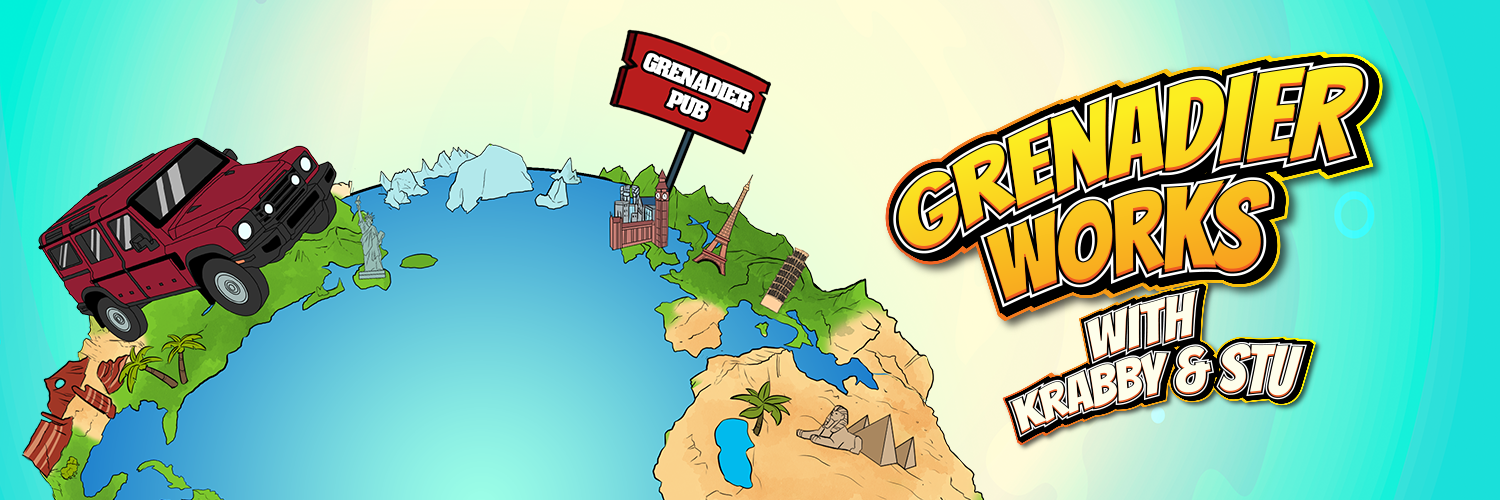Those knackers need a stronger scrotumNot seen or heard of any, either here or on FaceBook.
Having said that, a catastrophic failure of a CV is likely to trash all of the evidence!
BRM had a series of CV joint failures in their F1 cars back in the '50s, where the grease was flung into the rubber boot. went unbalanced, then tore itself apart, with the CV joint failing several laps later.
View attachment 7914146
The Grenadier Forum
Register a free account today to become a member! Once signed in, you'll be able to contribute to the community by adding your own topics, posts, and connect with other members through your own private inbox! INEOS Agents, Dealers or Commercial vendors please use the contact us link at the bottom of the page.
You are using an out of date browser. It may not display this or other websites correctly.
You should upgrade or use an alternative browser.
You should upgrade or use an alternative browser.
FixedI don’t think you’re allowed to post things like that anymore. Are you a forum moderator

I suppose that begs the question: has anyone with a 2025-reg Grenadier, with unmodified suspension or steering geometry, had a front prop-shaft CV joint fail? Hopefully an upgrade has been made — albeit discreetly, with no acknowledgement from Ineos
edit. ;- thinking about I suppose an acknowledgement that the design has been changed , would be like admitting that the original design was flawed.
If Ineos made a public announcement they'd quickly find themselvers on the hook for a front propshaft replacement for every vehicle previously sold. That's going to look bad on the quarterly statement. On the QT the shafts get replaced in small bunches over a longer time span.
Good Question Lab Rat. The issue is once a failure begins, the boot will get shredded either way. I cannot be sure if mine was pinched and came apart, or bound up under compression shredding the bearings, then tearing the boot, Was not the c clip for me. Compared to large U joints and double cardons, its not nearly as robust. But then again, have there even been any rear drive shaft failures yet? And of course the rear takes more load.
The front takes most of the load until the center and rear are locked. On sealed surfaces it's almost a front wheel drive vehicle unless I'm missing something.
I get what you’re saying. But some reassurance would go a long way in allaying the fears of owners and prospective ownersIf Ineos made a public announcement they'd quickly find themselvers on the hook for a front propshaft replacement for every vehicle previously sold. That's going to look bad on the quarterly statement. On the QT the shafts get replaced in small bunches over a longer time span.
The front takes most of the load until the center and rear are locked. On sealed surfaces it's almost a front wheel drive vehicle unless I'm missing something.
Still 3 weeks into getting my rear diff replacement authorized, despite all the documentation and communication. Not a cheap repair since they want to study it, but it will be 6-8 weeks in the shop at least. And then I still have to replace the driveshaft with the Agile one. I know what you are thinking! Its a 15 min job my private shop would just do for free if I stop by, but......... dealer claims its 3hrs of dealer shop time. So nope. To be frank, whether I add a Quartermaster to the stable in the future now rides on some of this. I realize warranties are not honored much any more by car makers, but Ineos has to do better as a new car company. Cant just do cheap and obvious recalls or defective parts.
The front takes most of the load until the center and rear are locked. On sealed surfaces it's almost a front wheel drive vehicle unless I'm missing something.
Correct.How do you figure? I was under the impression the center diff is just a standard open diff, with no provision to bias torque front or rear. This makes front to rear load (torque) distribution no different than side to side on an open/unlocked axle. The front should not be taking anymore load, not sure I understand the logic.
If the vehicle is producing say 200 ft-lb of torque, on a sealed surface each wheel will see exactly 50 ft-lb.
I'm not sure what the reality is, in my mind should be fairly equal until slipping. Perhaps some bias in weight shift as accelerate forward. Would love a real time torque reader.How do you figure? I was under the impression the center diff is just a standard open diff, with no provision to bias torque front or rear. This makes front to rear load (torque) distribution no different than side to side on an open/unlocked axle. The front should not be taking anymore load, not sure I understand the logic.
On sealed roadways the front wheels will scribe a longer arc than the rear while turning. With the center unlocked the engine torque will be shunted to the front outside wheel unless traveling in a straight line. This mimics front wheel drive vehicles with open front differentials and only applies when driving the vehicle in "all wheel drive". With the center locked (traditional 4 wheel drive) the power will flow to the outside wheel on both the front and rear axles during turns. Driving straight it's theoretically equal traction to all wheels. Lock the rear and differential action stops meaning a lot of stress across the locked rear axles. Of course we never lock any diff unless on low traction surfaces.
I'm not edumacated so if anyone can describe this better - or correct my thinking - please do!
Edit: My example presumes using the vehicle as a daily vs. as a dedicated off highway vehicle.
I'm not edumacated so if anyone can describe this better - or correct my thinking - please do!
Edit: My example presumes using the vehicle as a daily vs. as a dedicated off highway vehicle.
Last edited:
On sealed roadways the front wheels will scribe a longer arc than the rear while turning. With the center unlocked the engine torque will be shunted to the front outside wheel unless traveling in a straight line. This mimics front wheel drive vehicles with open front differentials and only applies when driving the vehicle in "all wheel drive". With the center locked (traditional 4 wheel drive) the power will flow to the outside wheel on both the front and rear axles during turns. Driving straight it's theoretically equal traction to all wheels. Lock the rear and differential action stops meaning a lot of stress across the locked rear axles. Of course we never lock any diff unless on low traction surfaces.
I'm not edumacated so if anyone can describe this better - or correct my thinking - please do!
Edit: My example presumes using the vehicle as a daily vs. as a dedicated off highway vehicle.
An open differential always splits torque 50:50.
It makes no difference corners/straights.
Each wheel will get exactly 25% of the torque if the differentials are all open.
An open differential always splits torque 50:50.
It makes no difference corners/straights.
Each wheel will get exactly 25% of the torque if the differentials are all open.
I want to believe you but that would only occur when all wheels have equal traction and are rotating at the same speed (and have equal circumferences). That doesn't occur when turning. It would also mean there's no need for front/rear lockers.
Ex: if I drive our Grenadier slowly forward onto a patch of glare ice where, for argument's sake, there is a zero coefficient of friction, then forward progress will stop as soon as any one wheel breaks traction. The entire torque of the engine will be transfered exclusively to that one wheel via the open center and open front/rear axle differentials. All three other wheels will remain stationary (minus some internal resistance within the spider/side gear assembly). This has happened innumerable times to hundreds of thousands of motorists and is the reason torque biasing and locking differentials were created. If you try to accelerate off of the icy surface the spider/side gear assembly will spin like a maniacal whirlygig and eventually burn out. This too has happened a tremendous number of times. Ask a repair shop in snow country.
Open differentials are designed to allow differentiation in wheel speeds ideally on high traction surfaces. Torque to each wheel is equal when traveling straight ahead - not in a turn. Even drag racers use auto lockers or fit spools because as soon as one wheel breaks traction - i.e. spins at a higher rate of speed than the other - forward momentum is lost. Hasn't anyone here done a one wheel burnout in their parents sedan? In other words: Torque is only equal when traction and rate of travel is equal. The rate of travel (tire revolutions) varies side to side when turning as if there was some loss of traction - albeit minimal - in the wheel spinnig fastest.
Odd point... iirc the humble Ford model T difdn't originally have a differential. Only a single rear wheel was driven eliminating the need for a diff when cornering. I'll step down now.
Similar threads
- Replies
- 6
- Views
- 862
- Replies
- 66
- Views
- 4K
- Replies
- 0
- Views
- 438



